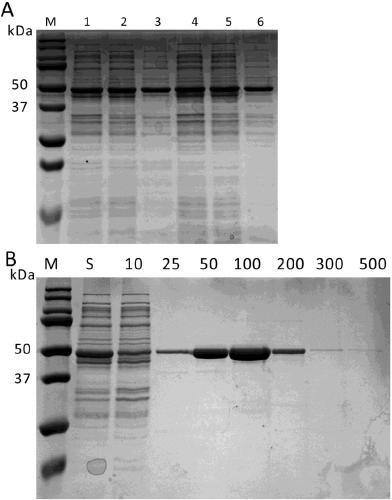Novel tagatose 6-phosphate 4-locus epimerase and application thereof
A technology of tagatose phosphate and epimerase, applied in the direction of racemase/epimerase, isomerase, application, etc., can solve the problem of unsuitable large-scale production of tagatose and poor thermal stability advanced questions
- Summary
- Abstract
- Description
- Claims
- Application Information
AI Technical Summary
Problems solved by technology
Method used
Image
Examples
Embodiment 1
[0051] The cloning of embodiment 1TiT4E gene
[0052] We obtained the amino acid sequence of the polypeptide 6-phosphate tagatose 4-position epimerase from NCBI (https: / / www.ncbi.nlm.nih.gov / ), and the NCBI Reference Sequence of the sequence is WP_019907213.1 (SEQ.No.1), we named the polypeptide TiT4E, and TiT4E was annotated as a hypothetical protein on NCBI, and was classified as a 6-phosphate tagatose kinase, which is to convert tagatose under the action of ATP Enzyme that phosphorylates tagatose 6-phosphate. We then entrusted Wuxi Qinglan Biotech Co., Ltd. (http: / / qinglanbiotech.com / ) to design the polynucleotide (DNA) sequence encoding the polypeptide based on the amino acid sequence, and optimized the codons in the E. coli expression system. After optimization, The polynucleotide sequence is shown in SEQ.NO.2.
[0053] Wuxi Qinglan cloned the codon-optimized sequence into pMV vector to form pMV-TiT4E plasmid. We then used the forward primer GAA CATATG AACACCGAACATCC...
Embodiment 2
[0054] Expression and purification of embodiment 2TiT4E
[0055] Transform pET20b-TiT4E into Escherichia coli BL21(DE3), pick a single clone into 3ml LB medium containing 100μg / ml ampicillin, and culture overnight at 37°C and 220rpm. Take 1ml of overnight bacteria into 200ml of LB medium containing 100μg / ml ampicillin, 37°C, 220rpm until the OD600 value reaches about 0.8, add Isopropylβ-D-1-thiogalactopyranoside (IPTG) with a final concentration of 100μM, respectively at 37 °C and 18°C induced protein expression. Induce for 4 hours at 37°C and 20 hours at 18°C. After the induction, the bacteria were collected by centrifugation, resuspended with 30mM phosphate buffer (pH 7.0), and ultrasonically disrupted to obtain the cell disruption liquid, and the expression level of the enzyme was detected by SDS-PAGE, as shown in image 3 In Lane 1 and Lane 4 of A, perform high-speed centrifugation (12000rpm, 10min) on the cell lysate, and also detect the supernatant by SDS-PAGE, such ...
Embodiment 3
[0056] The enzyme activity assay of embodiment 3TiT4E
[0057]The method for measuring the enzyme activity of TiT4E is as follows: a reaction system contains fructose-6-phosphate, tagatose-6-phosphate phosphatase, buffer solution, and magnesium ions, and the growth amount of inorganic phosphorus in the reaction system is measured after the reaction is completed. Specifically, in a reaction system containing 100mM HEPES buffer, 10mM fructose-6-phosphate, 10U / ml tagatose-6-phosphate phosphatase (from Archaeoglobus fulgidus, the number of the gene on KEGG is AF_0444, the gene also Heterologous expression in Escherichia coli, purified by Ni-NTA column to obtain a large amount of enzyme), 5mM magnesium sulfate, 0.005 or 0.02g / L TiT4E, reacted at 60°C for 8 minutes. After the reaction was over, the reaction was terminated in an ice bath. The released inorganic phosphorus ions were determined by the method for determining inorganic phosphorus provided by literature (Anal.Chem.1956, ...
PUM
 Login to View More
Login to View More Abstract
Description
Claims
Application Information
 Login to View More
Login to View More - Generate Ideas
- Intellectual Property
- Life Sciences
- Materials
- Tech Scout
- Unparalleled Data Quality
- Higher Quality Content
- 60% Fewer Hallucinations
Browse by: Latest US Patents, China's latest patents, Technical Efficacy Thesaurus, Application Domain, Technology Topic, Popular Technical Reports.
© 2025 PatSnap. All rights reserved.Legal|Privacy policy|Modern Slavery Act Transparency Statement|Sitemap|About US| Contact US: help@patsnap.com



